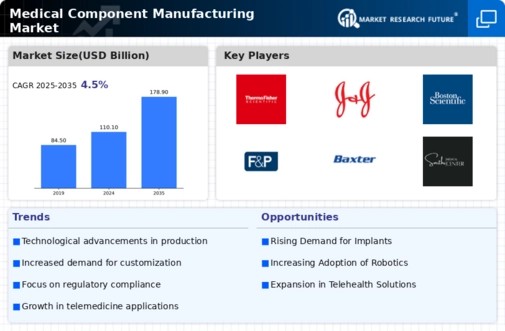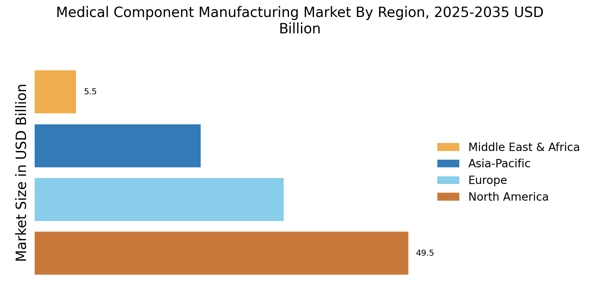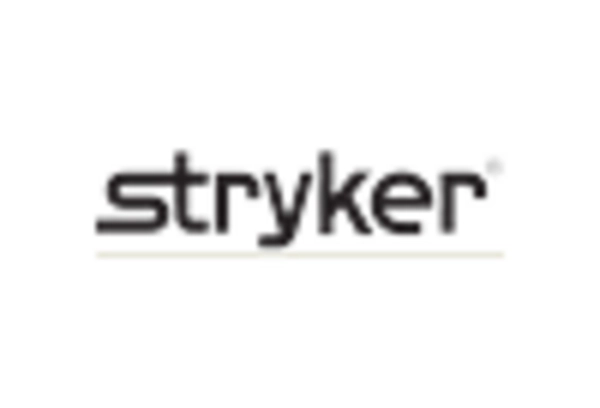Rising Demand for Medical Devices
The increasing prevalence of chronic diseases and an aging population are driving the demand for medical devices, which in turn fuels the Medical Component Manufacturing Market. According to recent data, the medical device market is projected to reach approximately 600 billion USD by 2025. This surge necessitates the production of high-quality components, as manufacturers strive to meet regulatory standards and consumer expectations. The need for innovative solutions, such as minimally invasive surgical instruments and advanced diagnostic tools, further propels the demand for specialized components. As healthcare providers seek to enhance patient outcomes, the Medical Component Manufacturing Market is likely to experience sustained growth, reflecting the broader trends in healthcare delivery.
Growing Focus on Patient-Centric Solutions
The shift towards patient-centric healthcare is influencing the Medical Component Manufacturing Market, as manufacturers increasingly prioritize the needs and preferences of patients. This trend is evident in the development of personalized medical devices and components tailored to individual patient profiles. The rise of telemedicine and remote monitoring solutions further emphasizes the need for components that enhance patient engagement and satisfaction. As healthcare systems strive to improve patient outcomes, the demand for innovative, user-friendly medical components is expected to rise. This focus on patient-centric solutions not only drives product development but also encourages collaboration between manufacturers, healthcare providers, and patients, thereby transforming the dynamics of the Medical Component Manufacturing Market.
Regulatory Compliance and Quality Standards
The Medical Component Manufacturing Market is significantly influenced by stringent regulatory requirements and quality standards imposed by health authorities. Manufacturers must adhere to guidelines set forth by organizations such as the FDA and ISO, which dictate the quality and safety of medical components. Compliance with these regulations not only ensures patient safety but also enhances the credibility of manufacturers in the marketplace. As the industry evolves, the emphasis on quality management systems and risk assessment processes becomes paramount. This focus on regulatory compliance is expected to drive investments in advanced manufacturing technologies and quality assurance practices, thereby shaping the future landscape of the Medical Component Manufacturing Market.
Sustainability and Environmental Considerations
Sustainability is becoming a critical driver in the Medical Component Manufacturing Market, as stakeholders increasingly recognize the importance of environmentally responsible practices. Manufacturers are exploring eco-friendly materials and processes to reduce their carbon footprint and comply with environmental regulations. The push for sustainable practices is not only driven by regulatory pressures but also by consumer demand for greener products. As a result, companies are investing in research and development to create biodegradable components and implement recycling programs. This commitment to sustainability is likely to enhance brand reputation and customer loyalty, positioning manufacturers favorably in the competitive landscape of the Medical Component Manufacturing Market.
Technological Innovations in Manufacturing Processes
Technological advancements are revolutionizing the Medical Component Manufacturing Market, leading to enhanced efficiency and precision in production. Innovations such as 3D printing, automation, and advanced materials are enabling manufacturers to create complex components with reduced lead times and costs. For instance, the adoption of additive manufacturing techniques allows for the rapid prototyping of medical devices, facilitating quicker iterations and customization. Furthermore, the integration of smart technologies, such as IoT and AI, is streamlining supply chain management and improving product traceability. As these technologies continue to evolve, they are likely to reshape the competitive landscape of the Medical Component Manufacturing Market, fostering a culture of innovation and responsiveness to market demands.


















Leave a Comment